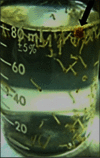Accelerating the Morphogenetic Cycle of the Viral Vector Aedes aegypti Larvae for Faster Larvicidal Bioassays
- PMID: 32908910
- PMCID: PMC7475756
- DOI: 10.1155/2020/7405421
Accelerating the Morphogenetic Cycle of the Viral Vector Aedes aegypti Larvae for Faster Larvicidal Bioassays
Abstract
Any bioassay to test new chemically synthesized larvicides or phytolarvicides against Culicidae and more harmful mosquito species, such as Aedes aegypti and Aedes albopictus, which specifically transmit dengue, yellow fever, chikungunya viral fevers as well as Zika virus, or Anopheles gambiae, a vector for malaria and philariasis, requires thousands of well-developed larvae, preferably at the fourth instar stage. The natural morphogenetic cycle of Aedes spp., in the field or in the laboratory, may extend to 19 days at room temperature (e.g., 25°C) from the first permanent contact between viable eggs and water and the last stage of larval growth or metamorphosis into flying adults. Thus, accelerated sequential molting is desirable for swifter bioassays of larvicides. We achieved this goal in Aedes aegypti with very limited strategic and low-cost additions to food, such as coconut water, milk or its casein, yeast extract, and to a lesser extent, glycerol. The naturally rich coconut water was excellent for quickly attaining the population of instar IV larvae, the most advanced one before pupation, saving about a week, for subsequent larvicidal bioassays. Diluted milk, as another food source, allowed an even faster final ecdysis and adults are useful for mosquito taxonomical purpose.
Copyright © 2020 José Domingos Fontana et al.
Conflict of interest statement
The authors declare that they have no conflicts of interest.
Figures





Similar articles
-
Evaluation of larvicidal, adulticidal, and anticholinesterase activities of essential oils of Illicium verum Hook. f., Pimenta dioica (L.) Merr., and Myristica fragrans Houtt. against Zika virus vectors.Environ Sci Pollut Res Int. 2018 Aug;25(23):22541-22551. doi: 10.1007/s11356-018-2362-y. Epub 2018 May 28. Environ Sci Pollut Res Int. 2018. PMID: 29808407
-
Larvicidal activity of Ottonia anisum metabolites against Aedes aegypti: A potential natural alternative source for mosquito vector control in Brazil.J Vector Borne Dis. 2017 Jan-Mar;54(1):61-68. J Vector Borne Dis. 2017. PMID: 28352047
-
QSAR modelling of larvicidal phytocompounds against Aedes aegypti using index of ideality of correlation.SAR QSAR Environ Res. 2020 Oct;31(10):717-739. doi: 10.1080/1062936X.2020.1806922. SAR QSAR Environ Res. 2020. PMID: 32930630
-
Chemical composition and larvicidal activities of Azolla pinnata extracts against Aedes (Diptera:Culicidae).PLoS One. 2018 Nov 6;13(11):e0206982. doi: 10.1371/journal.pone.0206982. eCollection 2018. PLoS One. 2018. PMID: 30399167 Free PMC article.
-
Essential oils and their chemical constituents against Aedes aegypti L. (Diptera: Culicidae) larvae.Acta Trop. 2020 Dec;212:105705. doi: 10.1016/j.actatropica.2020.105705. Epub 2020 Sep 19. Acta Trop. 2020. PMID: 32956639 Review.
References
-
- Guedes D. R. D., Paiva M. H. S., Donato M. M. A., et al. Zika virus replication in the mosquitoCulex quinquefasciatusin Brazil. Emerging Microbes & Infections. 2019;6(1):1–11. doi: 10.1038/emi.2017.59. - DOI
-
- Felix P. Dengue 2019. O Estado de São Paulo; 2020.
-
- WHO. Epidemiological update yellow fever. 2017. https://reliefweb.int/sites/reliefweb.int/files/resources/2017-dec-13-ph....
MeSH terms
Substances
LinkOut - more resources
Full Text Sources
Miscellaneous

